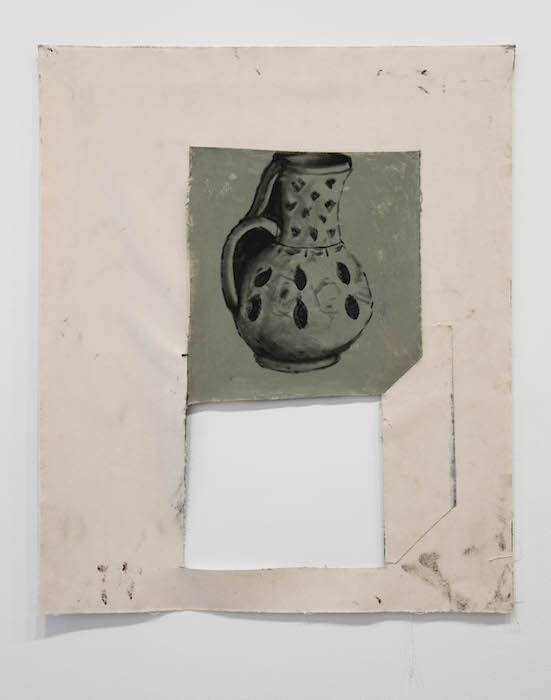The name “The Commercial” is unusually explicit for a gallery, but the title of the group exhibition currently on view in this one-room gallery in Sydney’s Redfern/Chippendale precinct is not to be taken so literally. While “Harvest” brings to mind food, crops, and still lifes, the exhibition also plays with the meaning of collecting for a future use. It’s an activity that is at the core of the working process of the three exhibiting Australian artists—Diena Georgetti, Patrick Hartigan, and Robert Pulie—who re-interpret or re-use carefully selected images and objects, transforming them into new artworks.
Take Hartigan’s subtle and playful studies of still life painting, full of amateur roughness and recycled supports. Late Harvest (2016) is an apparently quickly executed oil painting of a jug, which juts out from and overlaps its secondhand wooden frame. By placing one image over another, Hartigan strips the frame from its conventional function of protecting a canvas, transforming it into an essential part of the piece. Thus the frame is the painting, which is also a sculpture. Something similar occurs in Window (2016), a delicate and textured panel where three squares create a collaged painting that affirms the artist’s sculptural tendencies. In the upper central part of the canvas, a pitcher appears isolated on a grey backdrop. Below, the artist has cut out a square aperture that gives dimension to the image’s flat plane: the resulting void becomes a base visually supporting the jar. Hartigan’s still lifes, which resist formal categorization, revitalize, through postmodern trompe l’oeil and sophisticated intrigue, an often marginalized subgenre.
Some steps away are Pulie’s idiosyncratically humorous sculptures, ruminations on the morphology of unremarkable objects. Untill (2016) consists of a black cash box hung on a wall. The artist has cut two oval shapes into it which, combined with the lines of the open compartments of the till, evoke a skull: a play on materiality and semiology. Nearby is The Mind of God (2017), an oversized single die fixed on a table. Going against the logic of dice games, the cube is a recipient into which things are thrown. Visitors are invited to insert a ball into the die’s spots, which are actually interconnected holes forming labyrinthine passages. Pulie’s work creates a simple but engaging structure in which the black holes comically recall Stephen Hawking’s suggestion that God plays dice with the universe.1 Via thoughtful manipulations and rearrangements, Pulie gives dual meanings and renewed purpose to mundane articles.
Hung along another wall is Georgetti’s SUPERSTUDIO (2015-17), a polyptych of four panoramic and polychromatic acrylic paintings, each composed of three or four different panels with their own individual pattern. Georgetti chooses images of different styles and backgrounds, picturing them in her mind in order to later translate them into new paintings that are then grafted together. Images of art, architecture, interiors, textile design, and fashion are extirpated from their past, leaving them no other context that the renovated and ambiguous world that Georgetti grants them. SUPERSTUDIO scenes could evoke mountain landscapes, tiles, still lifes, rug patterns, and pottery designs with a modernist flavor. In these pastiches, form and color bring to mind Jean Arp’s “chance collages” and Alexander Calder’s geometric compositions. But Georgetti’s sources are elusive, and the unclean lines between different colors of paint, while giving the paintings character, also point to an unclear origin. Like memory, SUPERSTUDIO draws blurry lines to the past but remains colored by the present.
At the heart of the show is the act of collecting for creative re-use—either images of an archive, as in the case of Georgetti, or found materials such as those deployed by Hartigan and Pulie. Once the harvest is reaped, aesthetically and materially rich pieces yield a new parallel life to what otherwise would be fixed, ordinary, or disposable objects hidden by the soil.
“So Einstein was wrong when he said, ‘God does not play dice.’ Consideration of black holes suggests, not only that God does play dice, but that he sometimes confuses us by throwing them where they can’t be seen.” Quoted in Stephen Hawking and Roger Penrose, The Nature of Space and Time (Princeton: Princeton University Press, 1996), 26.








